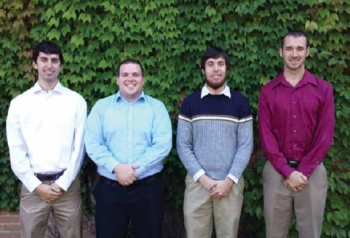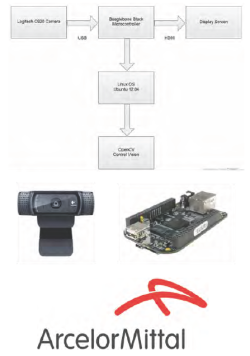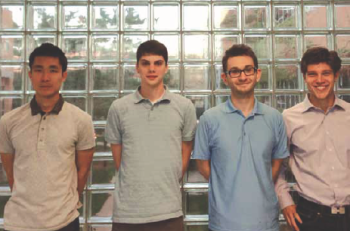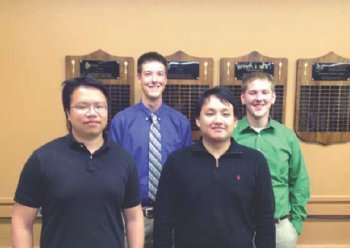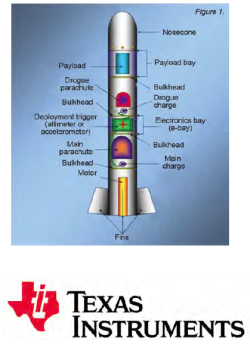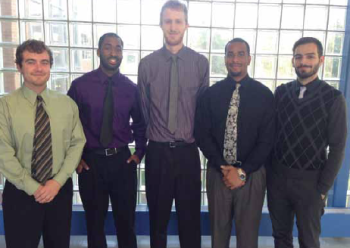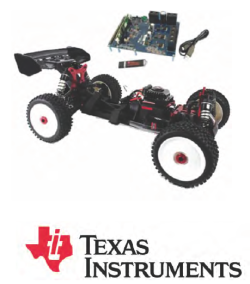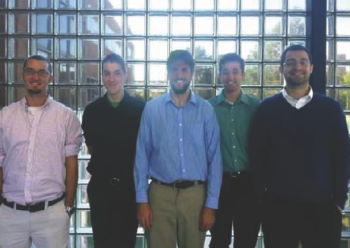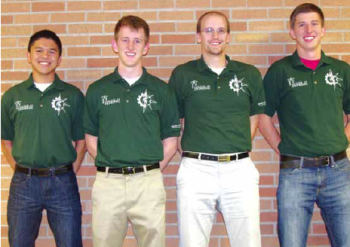Electrical Engineering
Projects
Electrical and Computer Engineering ECE 480 Senior Design is required of all electrical and computer engineering majors at MSU.
For information on becoming a project sponsor, please contact Gregg Motter.
The following are the project sponsors and projects for the fall of 2013:
MSU Technologies/National Science Foundation: Portable Micro-sensor Reader
Sensors are useful devices for collecting data about the world around us. Over the course of seven years, the Michigan State Adaptive Integrated Microsystems Laboratory (AIMLab) has developed a self-powered sensor that can measure strain forces in the environment. These sensors will be implanted into athletic equipment, so that researchers can better understand the causes and effects of head injuries.
This sensor module stores the data that it collects via onboard flash memory. Over time, the information accumulates on the sensor and is ready to be retrieved. A device needs to be designed that could connect to the custom input/output pins on the sensor module and pull the data off the memory. The reader needs to be portable and self-powered.
The Raspberry Pi minicomputer provides a cost- effective solution to solve the problem. It has all the components of a typical computer. The Raspberry Pi, coupled with a touchscreen LCD display, allows a user to input various commands which are labeled on the sensor module schematic.
The product is powered by a battery, creating a portable device that can fit in your pocket. All of the reader’s internals are housed in a custom enclosure that protects the reader from damage caused by accidents or the environment.
An important thing to remember when powering electronics is to consider the proper voltage requirements. This solution utilizes voltage regulators to provide a constant DC voltage to each individual component within the reader.

Team Members (L to R): Evan Gardetto, Brett Johnson, Ron Razalan, Thamer Alshuaibi, Yuval Levental (Not Pictured)
U.S. Air Force Research Laboratory: Wireless Sensor Network Diagnostic
The United States Air Force relies on wireless sensor networks for protecting its equipment and U.S. military personnel around the world. Thus, it is paramount that these sensor networks are working properly. In order to ensure the integrity of a sensor network it must be monitored for potential failures. This project revolves around creating a health diagnostic for detecting sensor node failures across the network in real time.
Our project consists of a wireless sensor network which measures environmental metrics including temperature, light, and humidity. The network is organized in a star topology with every sensor node solely communicating to a central cluster head. Every sensor node continually collects environmental information and then periodically transmits it to the cluster head. From there the cluster head forwards the information onto a computer where it undergoes analysis and is intuitively displayed.
In order to design a robust health diagnostic, more metrics must be monitored. Every sensor node also keeps track of internal metrics such as battery level and current draw. These internal metrics, in combination with environmental metrics, allow for a comprehensive network health analysis.
Ultimately, our project could be deployed in a variety of places; for example, in a pump station in order to ensure the pumps are properly functioning. A pump room operator must simply periodically check the computer to see the status of each pump and sensor to determine if maintenance is needed.
Robert Bosch, LLC: Infotainment and Navigation System Monitor
As Bosch strives to build quality systems, the monitoring of possible issues through on-road testing is necessary. The Infotainment system features also include the driver’s and passenger’s interface to the vehicle’s entertainment system. This is a central unit for communication and has a number of hands-free operational features, all of which require testing. Testing hours can range between a short ride to the gas station, or crossing a number of states.
Testing of the Infotainment system only includes the entertainment functions and GPS system. This testing is on-road and includes the monitoring of the GPS turn-byturn directions and the display screen, both monitored to ensure that the information being given to the driver is accurate and consistent with available routes on the road. Errors can result from the GPS system software or can be associated with possible user input.
Therefore, in order to detect possible issues with these features, a method of monitoring the driver and the system while on the road is needed. This information is collected with the purpose of re-creating, debugging, and ultimately fixing any issues found in the road or as a result of user input.
The team has developed a system consisting of 4 cameras and a computing unit. These modules will work together to record multiple views and will have post processing features such as time and GPS stamping.

Team Members (L to R): Joe (Yizhou) Jiang, RUdina Alhamzi, Scott Hansen, Danielle Valerie Guir, Jason Ostroski
ArcelorMittal: Hot Strip Mill Centerline Tracking
The finishing section of ArcelorMittal’s steel hot strip mill passes strips of hot steel through seven high pressure rolling stands to decrease the thickness of the strips. Inconsistencies in the strip’s temperature and the pressures applied by the seven rolling stands can cause the steel strip to bend from side to side. When this happens, the steel strip has the potential to bend and curve off of its intended path. The implemented design will provide a cost-efficient solution to numerically represent the curvature and reduce the occurrence of mill wrecks caused by curved steel.
In order to detect the problem quickly and efficiently, our design employs a high-definition webcam and powerful microcontroller, the BeagleBone Black. Using image processing templates supplied by OpenCV, a database of open source computer vision software, our microcontroller will be able to process the image matrix. The BeagleBone will then be able to detect the edges of the steel strip. After the edges are detected, the centerline of the strip can be calculated and stored in ROM. When the centerline varies outside of a tolerated level (defined by the American Institute of Steel Construction), a visual queue will appear on a display screen.
By allowing the hot strip mill operators to detect the curvature of the steel strip, they can more accurately adjust roller pressures to minimize the curvature in the next strip. The ability to quantize this data is imperative to minimizing costly downtime in the hot strip mill.
Chrysler Group, LLC: Advanced Testing Breakout Board
During the development of a new vehicle, a number of prototypes must first be designed and built. In order to accomplish this task in a timely manner, a carrier vehicle is chosen to serve as a base in which new technology is tested. The carrier vehicle’s wiring and general electrical architecture serves as a starting point for engineers to retrofit new and current technology. However, due to the expedited nature of prototype development, bench top studies are essential when testing and debugging communication schemes. As the number of modules on any given vehicle grows, a bench top test area can become cluttered and confusing to work with. Thus, there is a growing need for an advanced communications breakout board that will be used to test up to as many as ten modules at a time.
This advance communications breakout board needs to handle the modules by successfully supplying sufficient power and communication buses for any individual unit. The communication buses should not interfere with each other or pick up any outside noise from surrounding circuitry. All of these controls, along with voltage readings taken from the communications bus, need to be displayed on a graphical user interface that allows the engineer working with the modules to view any of these readings.
After designing, implementing and testing the final proposed solution, the team’s design is capable of handling the required number of modules and displays the correct readings and voltages within + 1% accuracy.
Resource Center for Persons with Disabilities: Expendable Computer Power Storage System
The Resource Center for Persons with Disabilities (RCPD) manages a program that scans textbooks to aid blind students. After the textbooks are converted into a computer readable format, they then use voice-recording software to create audio files. The RCPD wants to implement this program in a school in India, but the power grid is very unreliable, causing frequent power outages that last for a few hours at a time. To avoid this problem, there needs to be a way to power the computers independently of the power grid.
India’s power grid is archaic, and poorly maintained. Power outages due to high energy demand and broken power lines are common occurrences in India. Since the existing power grid is unreliable, at best, there needs to be an external energy supply in order to make the system completely independent from the power grid. Due to the sunny climate near the school, solar power is a good choice for an alternate energy source.
Steven Blosser from the RCPD has proposed the challenge to design an expandable power supply for a laptop computer lab that will use solar power to keep a battery bank charged in order to supply power to as many as 30 laptops. After designing the system, the team’s solution is able to power two laptops for eight hours and is able to charge the deep cycle batteries using solar power.
Texas Instruments: Electronic Parachute Deployment System
Model rocketry is a popular hobby for many, ranging from a fun educational activity for children to a highly technical recreation for adult enthusiasts. The basics of model rocket flight include liftoff by force of propellant, and a parachute system to retrieve it after descent. After a rocket has successfully lifted off from the launch site, the next concern is its descent- a rocket without a functioning parachute system will go “ballistic,” falling nose-first in a missile-like fashion. These falling rockets pose safety concerns for all onlookers in its path below. Too often, a failed rocket parachute system results in a broken rocket, and broken spirits for those who spent so much time and money designing it.
Texas Instruments lends sponsorship of this design team to provide an electronic solution to a model rocket’s parachute deployment. This electronic parachute deployment system (EPDS) will replace the basic timed-charge system commonly used in many model rockets today. It will employ the use of a fabricated printed circuit board (PCB) consisting of accelerometer and altimeter sensors to sense the g-forces and air pressure (respectively) acting upon the rocket, as well as an LCD to capture data obtained during the flight. These components will communicate with an MSP430 LaunchPad and micro controller to deploy two parachutes during the rocket’s flight. The use of this EPDS will ensure model rockets have safe descents and a longer lifespan.
Texas Instruments : RC Car Drone
Texas Instruments is a renowned company specializing in semiconductors and consumer electronics. They have proposed a project involving the design, prototyping and testing of an RC car drone. The final product will perform as a functional drone that can be utilized by the Texas Instruments’ motor lab located in Dallas, Texas.
The RC drone will be controlled over the internet via a website, and locally using a Bluetooth interface. The purpose of the project is to create a user-friendly application of Texas Instruments’ DRV8301 microcontroller kit in order to demonstrate the capabilities of the control algorithms. The coding and communication scheme of the RC drone will serve as a predecessor for a flying drone in future development.
The brushless DC motor driving the drone requires a sophisticated control algorithm to function properly. The DRV8301 is designed specifically for brushless DC motors. The control board contains the MOSFET gate drivers and outputs for the 3 phases needed for the motor. The microcontroller sends the inputs to the gate drivers that it receives from the phone via a Bluetooth connection.
The core component to making this project a success is the ability to send commands from the website to the onboard Android phone in order to control the RC drone. The design allows the drone to be controlled by a user from a website while receiving the drone’s GPS coordinates as well as visual feedback through the phone’s camera.
Michigan State Solar Car Team: Motor Controller for Sensored BLDC Motor
Our design team is tasked to build a motor controller for a brushless DC motor. This motor controller will be used to power the motor on the Michigan State University Solar Car. The Solar Car Team is one of the latest racing teams to be organized at Michigan State University. Since 2010 the team has participated in two races and has been unable to complete the race due to unreliable components. The Michigan State Solar Car Racing Team competed in the American Solar Challenge for the first time in 2012.
Ten miles into the race the NGM motor controller being used on the car failed and stopped working. During the attempt to fix the motor controller, it was found that the NGM controller lacked robustness to hold up to the demands of the car. The area of weakness in the controller was in the high voltage distribution section, particularly the MOSFETS which could not handle the current demand of the motor. With a new design the motor controller can be built to be more reliable and easier to repair. This will prevent the future car from being unable to race in its next event
A motor controller is an electronic component of a drive system that converts DC voltage into a three phase AC signal that can drive an AC motor. The motor controller converts the DC to AC using a 6-step inverter which is implemented with high power MOSFETS and a Microcontroller. The H-bridge of our motor controller can be seen modeled in CAD on the right.


